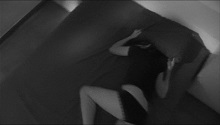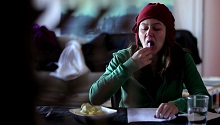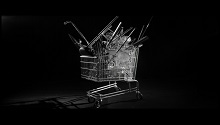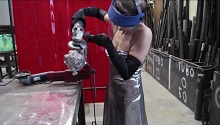Elisa Martínez & Co.
I was born in Palma de Mallorca on Friday 13 February 1981. My mother decided to change the destiny of her first-born by a few hours and made sure that I was legally born on Saturday 14th, “Valentine’s Day”. From day one, in this world, what I “am” is intertwined with what others want me to be.
Until I was 18 I studied acting at different schools in Palma de Mallorca. The game of “being an actress” started to feel dangerous and I gave it up. How can I be other people if I don’t even know who I am?
I arrived in Barcelona in 1999 and started studying filmmaking at the CECC, where I was involved in over 30 shorts and other audiovisual projects. I was part of several departments, but I soon turned to Artistic Direction and Props. I was drawn by the ability to explain using objects and space. In those early years I didn’t do any directing because I felt I didn’t have anything to say. In 2001, with the Discusión 14 collective, I co-directed the documental 200 Km, and it was then that I discovered how interesting and necessary it is to talk about reality.
In the course of those years I combined my work (stage design and construction, ephemeral architecture and theatre props) with my own personal projects, works that brought together installation, sculpture and video. In 2015 I graduated from the Arts Faculty of Barcelona University.
About my videos
Using your own life as artistic material could be called emotional exhibitionism, a game of acting on the stage of life (as Antonin Artaud said) or simply seeing your body as one tool more.
Oscar Cornago said: “Video is a space of resistance.” My works are the “place” where I unload personal sensations, the product of everyday conflicts of a social nature. For the purpose of sharing reflections on the “metabolisation” of imposed phenomena, based on improvisation and the careful construction of a script with critical, autobiographical content. I tend to think, like Virginia Woolf, that “[…] masterpieces are not single and solitary births; they are the outcome of many years of thinking in common, of thinking by the body of the people, so that the experience of the mass is behind the single voice”.
I’m interested in capturing the moment; I never do trial runs, the first shot is always the right one. The combination of a spare script and a spontaneous image is what most attracts me. It’s essential that people get the message, that’s why I’m very explicit but perhaps not very poetic. Television, cinema, popular symbolism, consideration of the artist’s work, caricature, irony and the search for my own identity are the elements I draw on.
What does being an artist mean? Who is responsible for legitimating an artist’s work? How can an artist express herself? To what extent do prizes help to consolidate her career? Is an artwork necessarily beautiful? What do we understand by beauty today? What do we understand by art? The work of Elisa Martínez & Co. addresses issues like these with humour and bite. With a highly autobiographical tone, in videos like En los museos no hay gotelé (2012), Ser Artista (2014) and Éxito seguro (2015), she uses her circumstances and the people around her (her parents, her colleagues and even herself) to try and find an answer to all of these and many other questions.
In the form of a direct interview (in this case with her parents), Ser Artista [Being an artist] reflects on what artists mean to society today. How do her parents view the fact that she decided to be an artist? How does the rest of society see artists in general? Are commonplaces about the bohemian 19th-century artist still valid? Then, En los museos no hay gotelé [There’s no stippling in museums] is a dissection—as parodic as it is forceful—of all the continuing clichés about the world of art, about the cryptic works and imposture of certain artists, about elitism in art, about the art market and the inevitable speculation it involves, about the impossibility of taking it apart from its social and critical function, about its relation with people, their routines and their everyday lives. While in these two works Elisa Martínez & Co. takes the art world as a point of departure, in Éxito seguro [Success Guaranteed] she reflects with irony and a touch of bitterness about the fate of all the film students in the years leading up to the crisis who embarked on their studies with expectations that turned out to be rather different to harsh reality (a considerable number of graduates who now get by as best they can in precarious jobs that have little or nothing to do with their interests). On the screen, faced with the impossibility of winning a Goya (the most obvious and high-profile representation of success in this country’s film context), Elisa Martínez & Co. makes her own, using a mould to make the bronze figure with the utmost professionalism. Meanwhile, voiceovers manifest the difficulties met by constant and frustrated attempts to become a professional in the film world.
But the artist’s work does not reflect only on the world of art and cinema. The Best or Nothing (2013) is the product of a comparison of two facts: the increase in the production and sale of luxury cars in 2012 and the proliferation of the use of supermarket trolleys to collect scrap metal in the city of Barcelona. The work takes these two facts to offer a scathing criticism of neoliberal capitalism, of all bodies that wield power by coercive means, of the overproduction and overconsumption that society imposes on us. This criticism is also evident in the work Tengo que… ([I have to…] 2010), a video that reminds us of all the pressures that contemporary society constantly subjects us to, as well as all the pressures that we also subject ourselves to, more or less voluntarily. Because… what is the price we have to pay for living as part of a society like the one around us?
Marla Jacarilla (visual artist and writer)






